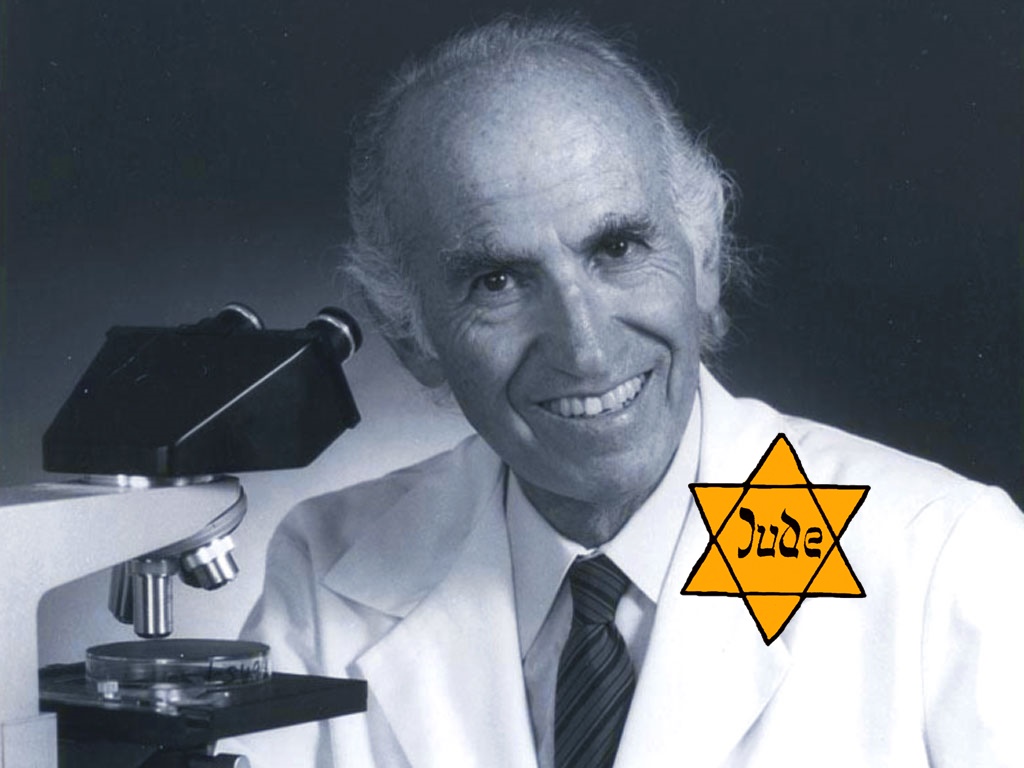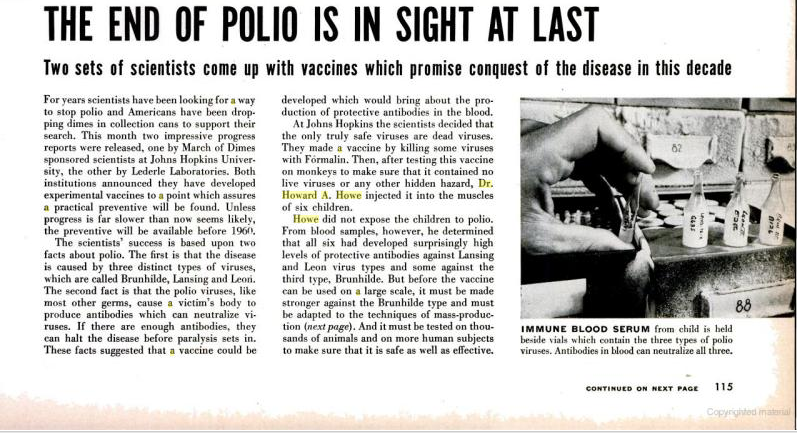Fading Light
Semitic Controversies
December 26, 2014

If you grew up in a White nation, especially in America, you have undoubtedly been force-fed that Jewish self-promotional propaganda story about the Jewish Dr. Jonas Salk working alone against all (anti-Semitic) odds to create a vaccine that nobody else could figure out in order to save dying legions of children from the horrors of polio. Like most Jewish invention stories, it turns out to be mostly fiction.
Before beginning, polio needs to be put into proper context as a disease. Polio at its most virulent was about as common as measles—everyone got it. Nearly all of them naturally developed an immunity to it without assistance from a vaccine. Most of them never even knew they had once had it because they suffered no effect whatever. Of those who did not develop an immunity, a tiny fraction suffered severe complications, occasionally included lifelong paralysis or the loss of the ability to breathe.
Polio may never have been the problem that many believed it was in any case. Dr. Christopher Kent discusses this in ‘The Polio Vaccine Myth’:
‘In the 1950’s, the sophisticated virological techniques of today did not exist. And the technology that existed was rarely available to practicing physicians. Therefore, most diagnoses were based upon clinical observation, not sophisticated virological studies. Since polio was epidemic, most physicians were cavalier in making a diagnosis of “non-paralytic poliomyelitis” in children presenting with vague symptoms of muscle aches, malaise, and fever. Since polio was “going around”, such children must have had polio. . . . Interestingly, as the number of polio cases decreased, the number of meningitis cases increased.’
This assertion is well-supported: The Los Angeles County Health Index statistics for polio and meningitis, for example, show an almost perfect linear substitution of the latter for the former over the years from 1955 through 1966, and the authors go on to specifically state: ‘Most cases reported prior to July 1, 1958 as non-paralytic poliomyelitis are now reported as viral or aseptic meningitis.’
Interestingly, one of the most famous cases of supposed polio paralysis, that of FDR, may not have been caused by polio since the paralysis struck him when he was nearly forty. (The disease mostly affected children under the age of five.) (2)
Instead, it may have been from sexually contracted syphilis. This rumor was widespread during his lifetime, but liberals are not fond of it and Wikipedia won’t even mention the theory despite its prevalence. What liberals can’t change is the fact that syphilis does indeed sometimes cause paralysis and also that adult polio has always been quite rare.
In any case, a great many medical researchers were attempting to create a vaccine in the decades prior to Dr. Salk’s ‘miracle cure.’ The real inventor of the first successful polio vaccine for human beings was a White man named Dr. Howard Howe of Johns Hopkins University.
It took a bit of a search to find this, but it is easily confirmed from newspaper articles from 1952, three years before Salk’s ‘invention.’ For example, ‘The Day’, a newspaper in New London, Connecticut, carries a story on October 20th of that year called ‘New Vaccine May Hold Answer to Polio’ by William Manchester.
The story reads: ‘Using a vaccine made of killed polio virus, Dr. Howe found that it made children develop antibodies against the virus. He presented his findings today at the annual meeting of the American Public Health association in Cleveland. . . . The preparation of a triple vaccine made Dr. Howe’s work especially difficult.’
That latter sentence was included because Dr. Howe was also one of the lead researchers who first determined that polio virus came in three distinct forms.

Howe’s vaccine was prepared in exactly the same way using a formalin kill that Salk would later use to prepare his own. Howe, however, was a dutifully cautious scientist, not seeking fame and riches, but instead a safe, dependable vaccine. He warned in the same article that ‘the vaccine isn’t ready for use. . . . Further testing will be necessary to improve it.’
Apparently Howe had been paying attention back in 1935 when Drs. Park and Brodie of New York University announced that they had a polio vaccine and, ignoring many scientific advisors’ cautions against attempting mass inoculations without sufficient testing, injected thousands of children with their potion.
At the same time, Dr. Kolmer of Temple University, probably selfishly competing for the same desired adulation as the savior of polio victims, began injecting thousands of children with yet another untreated vaccine. The first proved to be worthless against polio and caused inflammatory allergic reactions in the brains of many patients. The second contained living, active, lethal polio virus. Many of the injected children from both sources were paralyzed or killed from the carelessness of these fame-seeking doctors of Salk’s ilk. Both of these disasters are discussed in Richard Carter’s ‘The Gentle Legions: National Voluntary Health Organizations in America’ (Doubleday 1961).
Salk took the careless risk he did because he wanted to be famous. David Oshinsky, author of ‘Polio: An American Story’, discusses Salk’s talent for appearing humble and disinterested while actually craving publicity and notoriety. Innocent children paid the price for it as Dr. Kent mentions this in his article:

‘Following a government-subsidized study of polio vaccine, the number [of victims] soared to an all-time high of more than 55,000 cases. A “bad batch” of vaccine produced by Cutter Laboratories was deemed the cause of many cases of polio.’
Curiously, this event never seems to get mentioned in the usual promotions of Dr. Salk the wonder-Jew. He more than doubled the number of polio cases that year because of his ego.
As Angela Matysiak explains in her 2005 MIT Technology Review article, ‘The Myth of Jonas Salk’:
‘On April 24, 1955, just days after the Salk vaccine went into use, polio broke out among children who had received shots from a batch made by Cutter Laboratories in California. Eleven died. It is usually asserted that the Cutter incident was caused by particular lots of vaccine that still contained live polio virus, but the presence of the live virus has never been satisfactorily explained.’
What that last sentence means is that more research and testing should have been done before mass inoculation began, exactly as Dr. Howe, the real inventor, cautioned.
Meanwhile, few social conflicts are more humorous than Jews competing with each other for money and recognition. The supposedly humble and selfless Dr. Salk revealed his true colors in the early sixties when the polio vaccine of another Jew, Dr. Albert Sabin, began to be used more frequently than his own.
Salk, ignoring the statistics of accidental infection from his own quacksalving, asserted that Sabin’s vaccine was dangerous and was ‘the principal if not the sole cause of the 140 polio cases reported in the U.S. since 1961. At the present time the risk of acquiring polio from [Sabin’s] live virus vaccine is greater than from naturally occurring viruses.’
The motivation for this hypocritical fear-mongering was a long-standing competition between Salk and Sabin to be seen as the new Pasteur curing the world’s children of polio. Naturally the conflict started over funding. Basil O’Connor, then president of what is now called the March of Dimes, was a non-scientist with control over a large amount of tax-based and contribution-based polio research money. He was also a close friend of Dr. Salk and dreamed of forcing out a vaccine by the fastest (and least safe) means possible.
This meant Salk was getting more green than Sabin, prompting the latter to write to O’Connor in frustration: ‘Would it not be better if you as President of the National Foundation of Infantile Paralysis observed a more impartial attitude regarding the scientific work and contributions of all scientists whose work is supported by the donations from the American people through the Foundation which you so ably lead?’
Sabin also had a field day with the massive number of accidental infections from Salk’s vaccine.
Matysiak notes that Salk’s vaccine was not a great success in any case: ‘One of the main concerns was that the Salk vaccine did not prevent infection in the gut and thus did not break the chain of transmission.’
In other words, the Salk vaccine did only enough to keep itself, and its creators, in the money: It had to be administered repeatedly, boosted, and this had to be done for all children whose parents did not wish them to contract the disease because the vaccine did not really kill it.

Sabin’s vaccine, too, had a massive flaw: Since it used a live, benign virus instead of a killed virus, it allowed for the possibility of mutation of the benign disease back into a deadly form. These were both problems that Howe wanted to overcome by taking more time, doing more testing, and collecting more data, but the Jews saw money and fame on the horizon and didn’t want facts or ethics to stand in their way.
Nor did they intend to let anyone else share their limelight. Salk’s ego and refusal to acknowledge the contributions of his other team members at the lab was well known. Oshinsky writes that ‘once the goal was reached, the group [working with Salk in the laboratory] would split apart amidst charges that Salk had not appreciated, much less acknowledged, the collaborative nature of his success.’
History has certainly justified their claims as their names are not even mentioned when his comes up.
Salk had neither humility nor indifference to wealth, though he tried hard to project the impression of possessing both in abundance.
For example, he tried to mislead public opinion of himself in a 1955 television interview about his polio vaccine by answering a question about who owned the patent on it with the humble-sounding response: ‘The people [own it], I would say. . . . Would you patent the sun?’
What Salk chose not to reveal is that actually they had investigated the possibility of a patent on the vaccine, but found that there was too much dependency on the research and achievements of others to support the patent claim. In a manner of speaking, this Jew actually had tried to patent the sun, failed, and was attempting to instead claim impartiality to money. (3)
And what became of the selfless Dr. Howe, who sought neither fame nor riches and did not fight the Jewish propaganda machine that has made Salk a household name?
He went back to work on the other remaining medical problems of his time.
The Jews and their minions could not be happier about his quiet acquiescence: Of the seventeen scientists celebrated in bronze in the Polio Hall of Fame in the Georgia town of Warm Springs, it is only the real inventor of the polio vaccine, Dr. Howard A. Howe, who does not have a page on Wikipedia, at least at the time this article is being written. It is as if someone interested in perpetuation of a pro-Jewish invention myth does not want people to learn the truth about the matter.
How typically Jewish.
References
(1) http://www.vaclib.org/sites/debate/polio.html
(2) http://www.learnnc.org/lp/pages/4067
(3) http://www.biotech-now.org/public-policy/patently-biotech/2012/01/the-real-reason-why-salk-refused-to-patent-the-polio-vaccine-a-myth-in-the-making
